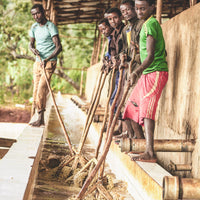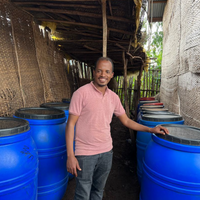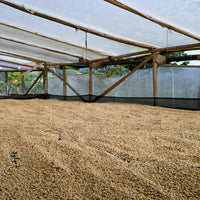Indonesia Gunung Tujuh
Origin: Indonesia
Region: Sumatra
Sub Region: Kerinci, Gunung Tujuh
Altitude: 1400 - 1700 meters above sea level
Cooperative: Koerintji Barokah Bersama Cooperative
Farmers: Small Holder Farmers
Variety: Andung Sari & Sigarar Utang
Process: Anaerobic Natural
Tasting Notes: Boozy and complex with notes of blueberry, tropical fruits, vanilla and milk chocolate.
The 320 members of the Koerintji Barokah Bersama Cooperative live and farm on a plateau that sits at the foot of Mount Kerinci on the island of Sumatra. Mount Kerinci is one of the many volcanoes in the Pacific Ring of Fire, a 40,000-kilometer horseshoe-shaped series of 452 volcanoes that are part of an almost constant dance of eruptions and plate movements. Mount Kerinci’s historic eruptions have assured that the surrounding area is lush and verdant thanks to the deep supply of fertile volcanic soil.
The co-operative is managed by Triyono, who leads members in processing and roasting their own coffee. They have a fully outfitted roasting facility, including a cupping lab, next to the dry mill. This is especially impressive considering the cooperative was founded in mid-2017!
Almost all farms on Sumatra are small. On average, farms are between 0.5 to 2.5 hectares. Coffee is usually the primary cash crop for farmers, but most also intercrop their trees alongside vegetables, potatoes and fruit. This intercropped produce will make up a substantial part of the family’s diet for the year.
In addition to growing coffee as a cash crop, many smallholder farmers also work at hired laborers at the nearby tea plantations. Tea is also a huge crop in the area. The bigger tea plantations are often near coffee farms. When the harvest is finished, coffee farmers will go there and pick leaves under contracted labour.
There are more and more initiatives by farmers on Sumatra to organize themselves into cooperatives. In the past, farmers did not have much leverage to help themselves get better prices for their cherry or parchment. When they’re in cooperatives, they can share resources, organize training and negotiate better prices.
During the harvest season, coffee is handpicked, with labour usually supplied by the immediate family. After picking, the coffee will be delivered to a UPH collection centre.
Triyono oversees the activities on and around nine UPH stations owned by the cooperative. A UPH is a collection centre where coffee cherries are bought by the coop and where the coffee is processed before moving it to the central mill. Essentially, a UPH functions as a small washing station.
With this Anaerobic Natural lot, coffee is first floated and separated by density before being laid on raised beds where workers remove underripes, overripes and damaged cherry. Then, ripe cherry is collected again and sealed in airtight, 20kg plastic bags that are stored in a cool, dry location (with temperatures between 18 and 22 degrees Celsius) for 7 days.
After 7 days, cherry is again laid on raised beds to dry. The beds are located in domes that protect the coffee from rain or harsh sunlight. The parchment will dry here for around 20 to 23 days, or until it reaches approximately 12% moisture content. When dry, the coffee is milled and sorted by hand.
Tryiono oversees the activities on and around nine UPH stations owned by the cooperative. A UPH is a collection center where coffee cherries are bought by the coop and where the coffee is processed before moving it to the central mill. Essentially, a UPH functions as a small washing station.
Indonesia is known for its unique ‘Wet Hulled’ Process (Giling Basah). Tryiono and his team are also trying to add to this tradition by diversifying the coop's processing methods. Our offer list usually featured Fully washed, Honey and Natural lots (among others) from the cooperative.
As of 2019, contributing farmers receive 9,500 rupiahs per kg of cherry. The result is that members of the coop have a fixed buyer for their cherries, and the profit of the coop at the end of the year is either invested in infrastructure to upscale quality or is shared with the producers. Farmers also receive technical support and seedlings for shade trees for on and around the farm. To join the coop, a producer pays a one-time membership fee of around 400 dollars (5 million rupiahs). To streamline the operation, there is an agriculturalist providing technical assistance to make sure the standard operation procedures are applied while processing at the different stations. Each UPH is located in a different area and receives cherries from different farmer groups.
Indonesia is perhaps best known for its unique wet hulling process (giling basah). Though its exact origins are unclear, wet hulling most likely originated in Aceh during the late 1970s.
Wet hulling’s popularity can be attributed to producers’ need for prompt payments. It was also adopted specifically by many producers who lacked the drying infrastructure that was needed to shelter drying parchment from the high humidity and inconsistent rainfall typical in Sumatra. At higher elevations with constant humidity and unpredictable rainfall, drying can prove to be slow, risky and difficult.
The basic process for wet hulling is as follows: Cherry is harvested and pulped at or near the farm, on small hand-cranked or motorized pulpers. The coffee is fermented overnight (in small tanks, buckets, or bags) and washed with clean water the following morning. Parchment is sun-dried for between half a day and two days, depending on the weather, to allow for skin drying which eases the removal of parchment.
At this juncture the moisture content is between 30-40% and parchment is delivered to a processor (often by the village collector) for wet hulling. A wet hulling machine is larger, requires more power, and runs at a faster speed than a traditional dry huller. After the hulling, the coffee seed is whitish and pliable and is called labu. It is laid out to dry on tarps or patios, where it reduces in size and moisture to 14-15%. This stage the green coffee is known as asalan - unsorted and with defects. Much of the internal commercial trade is for asalan. Exporters, most of whom are based in Medan, will finish the drying down to 12-13%, sort and prepare for shipment.
Our premium and specialty wet hulled coffees are produced in direct collaboration with village collectors and processors so that the drying, storage, and lot integrity remain in place from the farmer all the way you. In this way we can export cleaner, more stable and more traceable regional lots.
Indonesia has a long coffee producing history, but recently their coffees have been overlooked by the specialty market. Thanks to our innovative and ever-expanding supply chain, we are proud to bring you high-quality coffees from many of Indonesia’s unique regions, accompanied by in-depth traceability information.
Indonesia is perhaps best known for its unique wet hulling process (giling basah). Though its exact origins are unclear, wet hulling most likely originated in Aceh during the late 1970s.
Wet hulling’s popularity can be attributed to producers’ need for prompt payments. It was also adopted specifically by many producers who lacked the drying infrastructure that was needed to shelter drying parchment from the high humidity and inconsistent rainfall typical in Sumatra. At higher elevations with constant humidity and unpredictable rainfall, drying can prove to be slow, risky and difficult.







